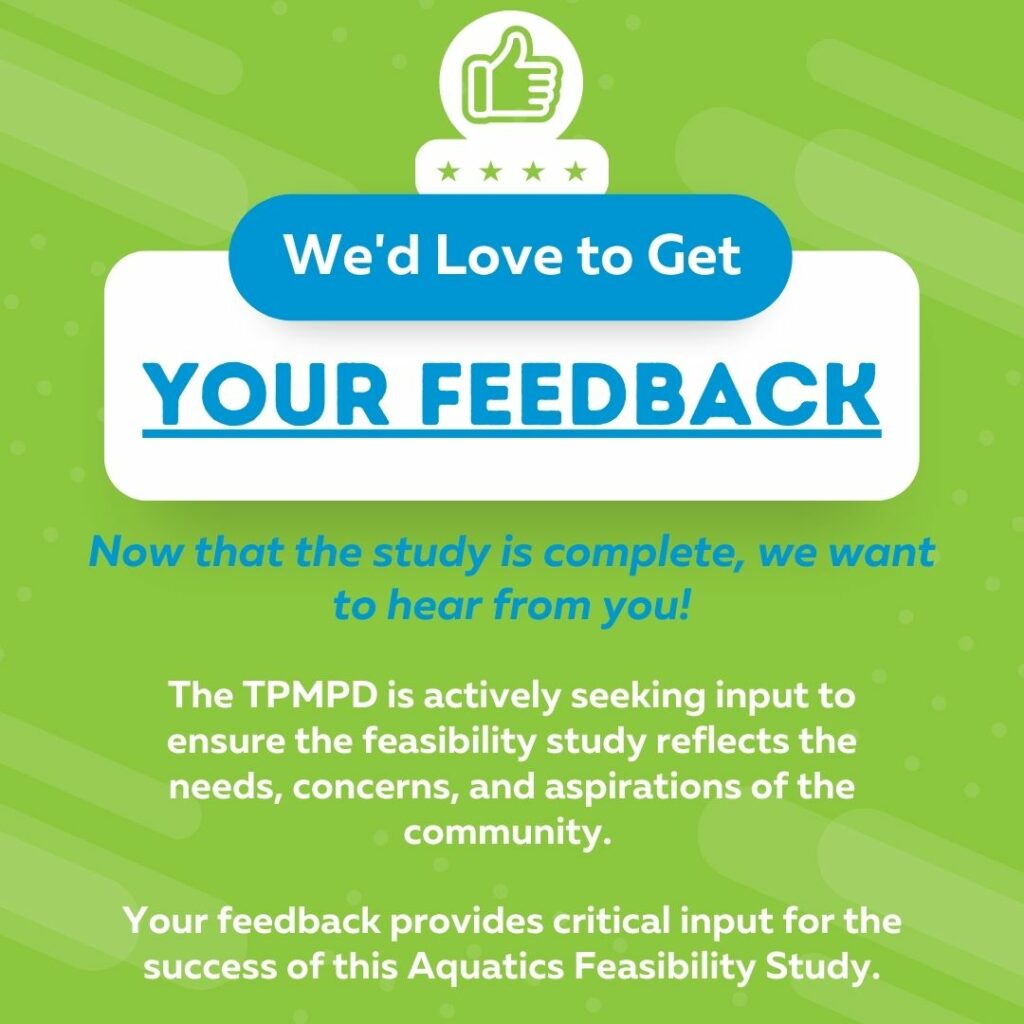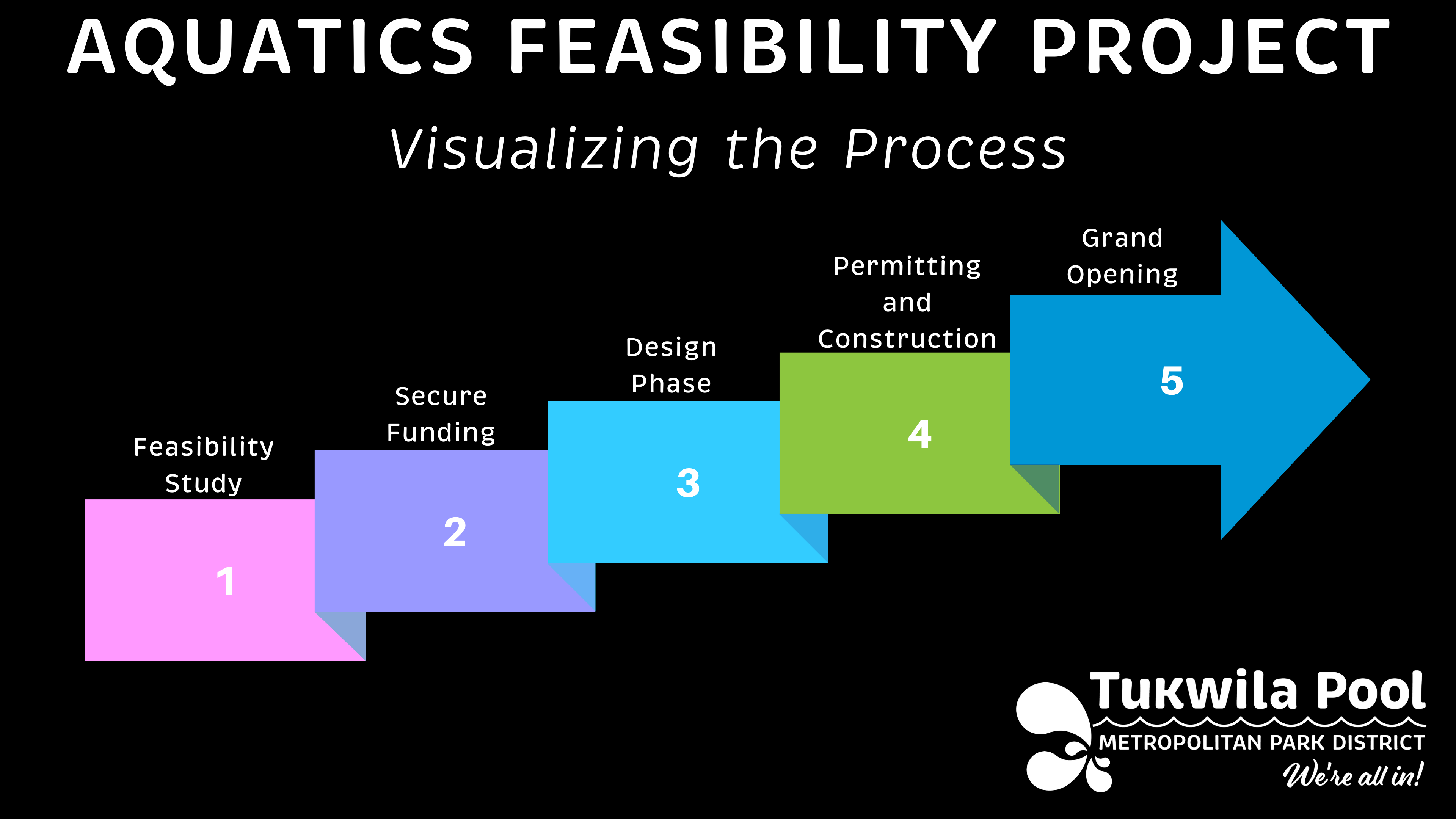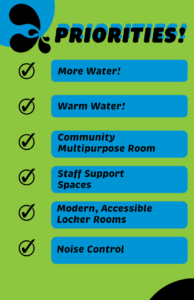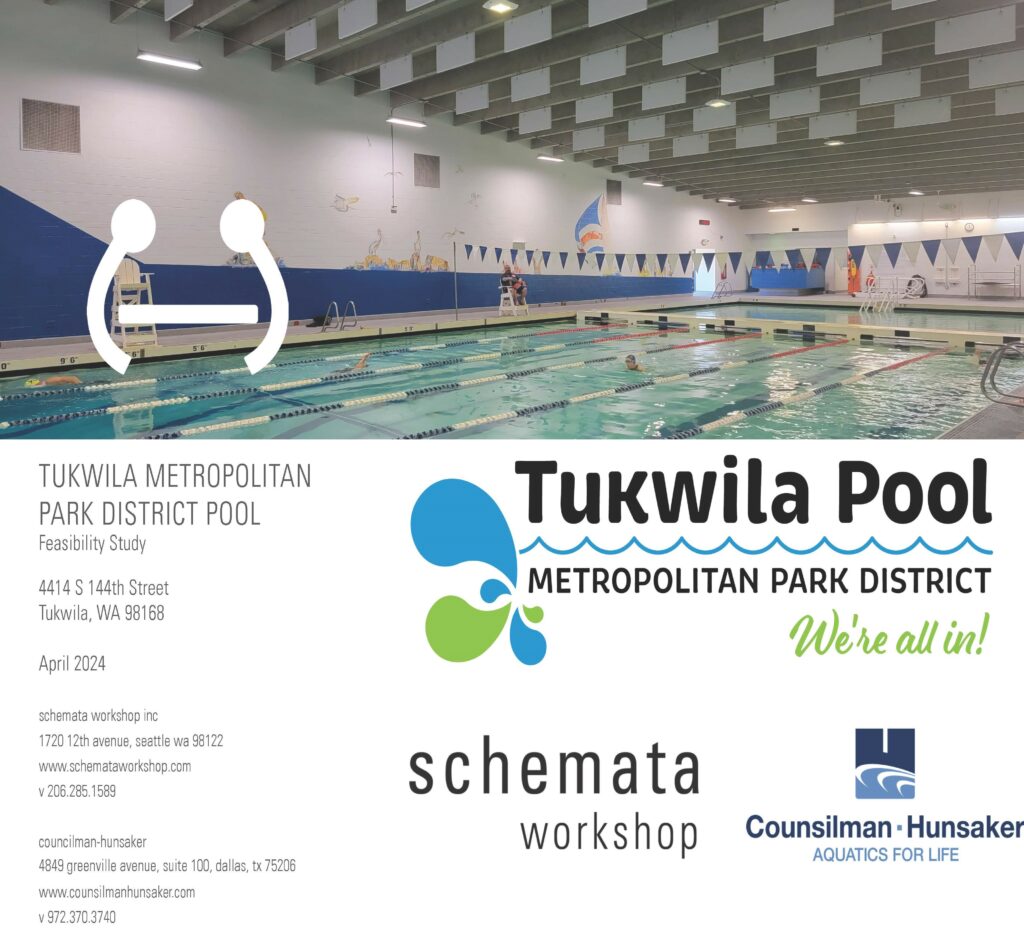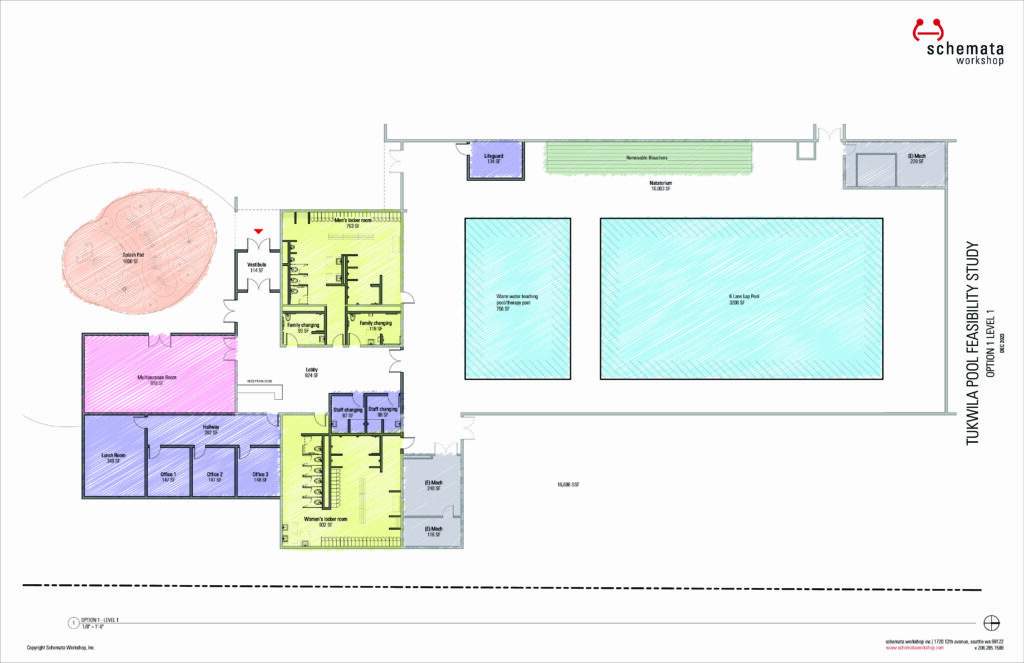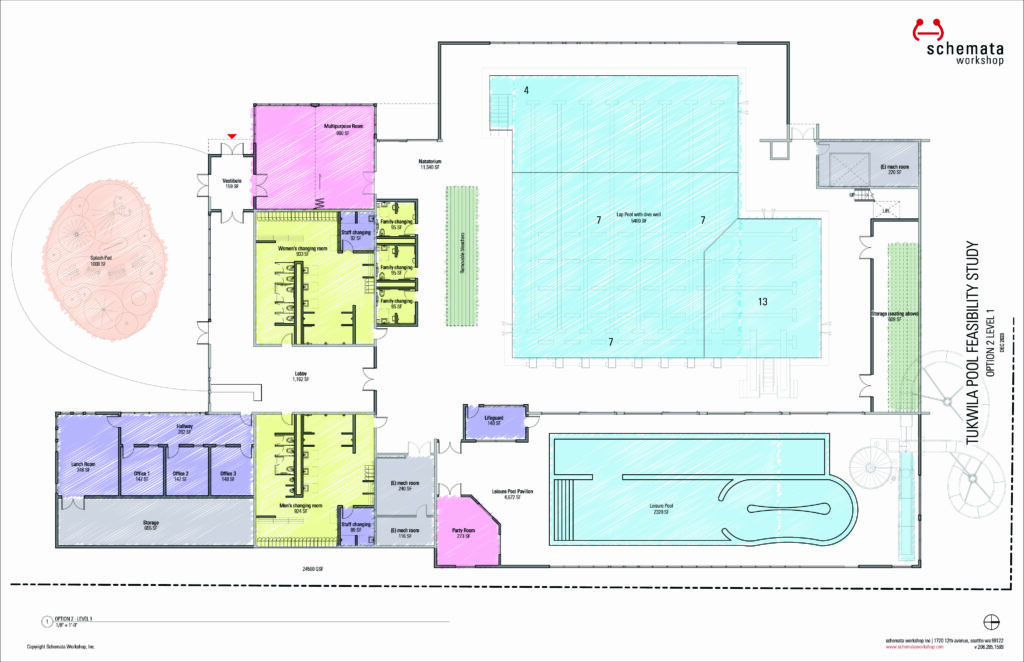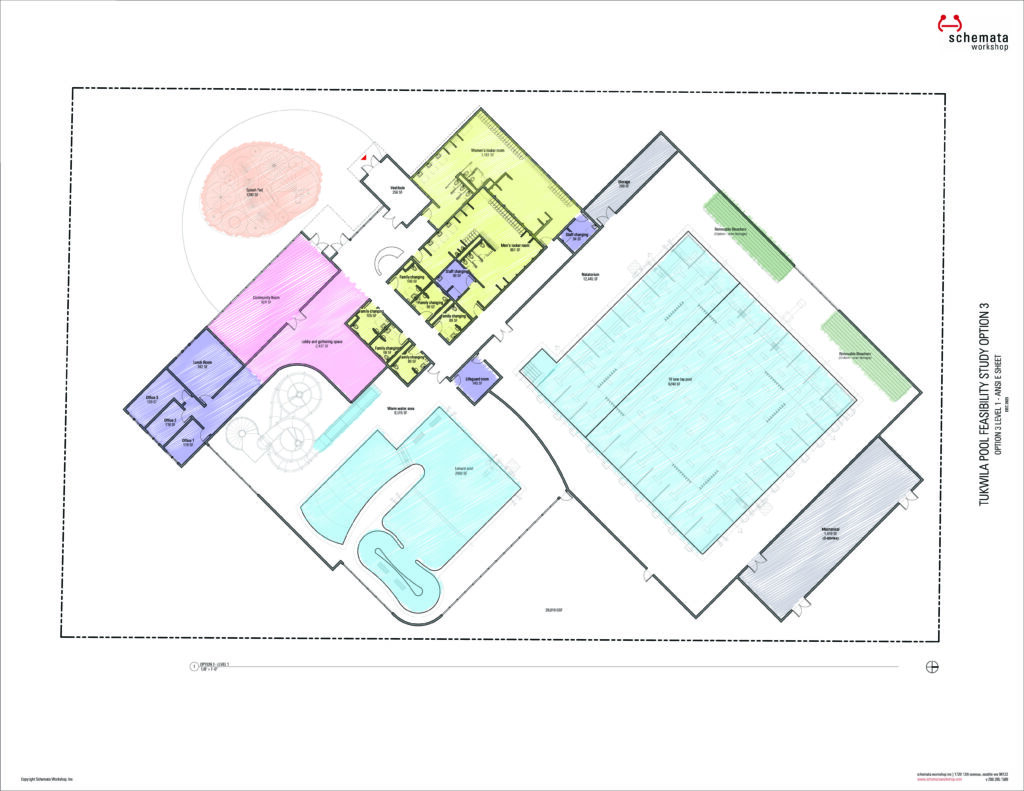
The Tukwila Pool Metropolitan Park District (TPMPD) released an Aquatics Facility Feasibility Study Report from the consultants, Schemata Workshop, Inc. and Counsilman-Hunsaker on May 13, 2024. The study’s purpose is to understand and evaluate options for improving aquatic programs, which include meeting the expanding demands for aquatics in Tukwila, and considerations for renovating or replacing the 50-year-old facility.

Vision, Future, and Feasibility: Frequently Asked Questions (FAQ)
The TPMPD Mission and Vision are to continue to serve all who wish to participate in a lifelong pursuit of water safety and recreational aquatics programs, to meet growing demand, while ensuring that all have access to a modern, accessible, and programmatically diverse facility.
The purpose is to develop a robust aquatic recreation facility feasibility study that will identify and analyze community needs and research options for the following:
- Remodeling the existing facility, including footprint expansion for additional aquatic features;
- Demolishing the existing facility and raising a new aquatic center on the current site; and
- Replacing the Tukwila Pool including potential sites for a new aquatic facility.
The Tukwila Pool is over fifty (50) years old, nearing the end of its useful life, and is nonetheless utilized beyond capacity. As a year-round indoor facility, there are ongoing needs and interests for additional programmable aquatic spaces, and the demand for facility use continues to present our greatest challenge. Based on an assessment of the pool completed in 2020, it requires significant health and safety upgrades and other major maintenance to keep it operational.
Guided by our Mission and Vision, the TPMPD aims to have a facility that will enhance our ability to better serve the Tukwila community by improving and expanding access to essential aquatic services such as:
- Swim Lessons,
- Water Safety Education,
- Lap Swimming,
- Fitness Aquatic Programming,
- Recreational Community Swims,
- School District Physical Education,
- Lifeguard Certifications,
- Community CPR/AED Certifications,
- Mako Sharks: Recreational Swim Club,
- Facility Rentals, and
- Employment Opportunities.
Managing the Tukwila Pool in a fiscally responsible manner remains a priority, and this includes choices that guide the Feasibility process.
These decisions have not been made yet. We have completed the first step focused on community engagement and information research. Considerations like design and financing will be addressed as the project continues.
It is still early in what will be a multiyear process. We will have many discussions, decisions to make, and substantial research involved before we will have a better understanding of when or if it will be completed.
Although it is still too early in the process to make that determination, the community has responded that proximity to the schools and community is an important consideration. The current site, leased from the Tukwila School District, emerged as the preferred location in the study. With the potential high level of community investment, it will be necessary for the Tukwila Pool and the Tukwila School District to negotiate a long-term lease.
The TPMPD will offer ways for the public to have their say and get involved. These will include, but are not limited to:
- Volunteer Opportunities
- Surveys
- Presentations
- Group Gatherings
- Social Media outreach and online information sharing
The TPMPD seeks to identify additional funding strategies which may include but not be limited to:
- Grant Opportunities including the King County Parks Aquatics Facilities Grant
- Community Contributions: private individuals and corporations support
- Joint-Use Agreements: may be difficult to manage different priorities, but can also be a significant source of revenue.
- Partnerships: Investment; Program; Operational
- Bonds: debt instruments (loans) secured by future revenue
Ballot initiative considerations will be addressed as the project progresses.
Probably not. The concept designs are intended to reflect and incorporate the community feedback to indicate priorities, and what might be possible. For example, a leisure pool could represent warm water for learning, exercising, and recreating, while a lap pool could reflect a cooler body of water for lap swimming, teams, and upper-level lessons.
Splash pads, also called spray parks, are community playgrounds that provide not only a safe, welcoming, accessible setting for aquatic play but also a necessary community cooling station.
Ultimately the design of the proposed changing rooms will be determined during the final project design process, but initial community feedback has indicated a preference for some larger, private changing areas, especially to better accommodate families and improve accessibility. These inclusive changing rooms are fully enclosed with a separate dressing area, shower, and toilet.
The Top 3 answers:
- Location
- Fee/Cost
- Schedule
The Top 3 Programs:
- Swim Lessons
- Lap Swim
- Water Aerobics
The survey results show that people use the Tukwila Pool for:
- Recreational Swimming – 60%
- Fitness / Wellness – 43.85%
- Lap Swimming – 36.92%
- Swim Lessons 37.69%
- Special Events – 13.08%
- Have not used the Pool in the Past – 13.08%
- Competitive Swimming – 10%
- Party Rentals – 10%
- Other – 5.38%
- Not aware of a Pool – 4.62%
- Stay informed- information available at: https://tukwilapool.org/tukwila-mpd-info/vision/
- Send us an email: info@tukwilapool.org
- Take part in upcoming engagement opportunities, workshops, and surveys (see below for details)
Projects achieve the best results with community involvement.
Participate in upcoming engagement opportunities, workshops, and surveys:
- Feasibility Study Feedback Survey: Click Here To Complete
- Join Us at One of Our Community Engagement Meetings:
- Saturday, August 17, 11 a.m. – First Annual Tukwila Hullabaloo Event – Joseph Foster Park: 13919 53rd Ave. S.
- Thursday, August 29, 6 p.m. – Informational Presentation – Tukwila Pool: 4414 S. 144th St.
- Send us an email: info@tukwilapool.org
- More to Come!
Feasibility Study Report Sections:
- Title Page / Table of Contents (Pages 1 – 4)
- Section 1: Executive Summary (Pages 5 – 8)
- Section 2: Zoning Analysis Summary (Pages 9 – 12)
- Section 3: Architectural Assessment – Existing Pool Facility (Pages 13 – 22)
- Section 4: Site Analysis (Pages 23 – 32)
- Section 5: Community Engagement (Pages 33 – 40)
- Section 6: Market Research & Analysis (Pages 41 – 46)
- Section 7: Concept Plans (Pages 47 – 60)
- Section 8: Operational Cost Analysis (Pages 61 – 70)
- Section 9: Opinion of Probable Cost Estimate (Pages 71 – 74)
- Section 10: Funding Strategies (Pages 75 – 78)
- Section 11: Appendix – Community Engagement Data (Pages 79 – 95)
Feasibility Study RFQ Scope Of Work
The Scope of Work included in Phase 1 of the Tukwila Pool Metropolitan Park District Aquatics Feasibility Study is intended to assist the Board of Commissioners, Staff, Community, and Stakeholders in determining future goals and outcomes necessary to ensure the project maintained forward momentum.
Schemata Workshop, Inc. is perfectly suited for this project based on past experience with aquatic facilities,
as well as their mission alignment to empower communities through architecture and design. They are
leaders in the planning, assessment, and implementation of community-based projects.
Professional Services Agreement – Schemata Workshop, Inc. (May 8, 2023 – September 8, 2023)
Approach to the Project: The following describe their specific knowledge and approach to the work:
Communication, Community Meetings and Public Engagement
Schemata Workshop has an intrinsically cooperative approach to design. We will be partners with the Tukwila Pool Metropolitan Park District and the stakeholders Committee through the feasibility study and beyond. We see this as just the start of the process. In addition to formal meetings at milestones, we will strive for regular and clear communications all throughout the project work and will always be available to the team. We value the opportunity and are widely recognized in the region for our leadership in successfully engaging the communities we work with. We welcome the opportunity to engage your public and foster a community-wide sense of ownership and investment in the project. Even during these times, where COVID-19 is still a concern for some, we know how to facilitate presentations and workshops to share information about aquatic and recreation trends and opportunities, and to listen to the feedback regarding priorities and concerns. By engaging public voices throughout, the Tukwila Pool will be embedded in the community from its inception. We’ve found that it is important for the community to see that progress is being made and that we aren’t just revisiting questions that they may feel have already been answered. In some cases, we have observed survey and engagement fatigue without seeing progress. Luckily swimmers often have strong advocate groups, that we can rely on an anchors for the community in staying engaged. We will want to identify those people/groups early on.
Since Counsilman-Hunsaker’s team consists of current and former swimmers, former lifeguards and swim instructors, as well as aquatic enthusiasts, they are well-versed in communicating, surveying and connecting with the various aquatic user groups. In fact, it’s the part of the job they love the most! With their experience in the aquatics world, they will be able to accurately develop an aquatics program that will meet the needs of these user groups while providing insight on the key components needed for successful aquatic offerings within the service area.
Market Research
Schemata and Counsilman-Hunsaker will work together with the communities in the service area to gather information on past reports, studies, PROS plans, surveys, and other relevant data. Some of this is information we are somewhat familiar with already, but will make sure it is all relevant and up to date. This will serve as the platform for which we can dive into the work for this feasibility study.
During this stage, we will assess many components of regional and similar aquatic facilities, including:
- The current level of aquatic programs and services available within the City and in neighboring communities
- An analysis of the best competition of duplication of services through other public and private aquatic providers.
- Recommendations for minimizing duplications and/or enhancing possibilities for collaborative partnerships
- Current policies, services, participation levels, operations and structure
- Deficiencies and opportunities for improvements for existing and new aquatic facilities
- Research of other area aquatic providers and how their service areas affect a future aquatic facility
This investigation will specify operating information, including amenities, fee structures and other operating data based on Counsilman-Hunsaker’s vast knowledge of aquatic facilities. A detailed demographic analysis based on service areas will show trends regarding population, income and age groups. An overview of these trends will help define the necessa ry aquatic elements.
Programming Documents Potential Components of the Aquatic Facilities
Understanding the various possibilities for aquatics programming will be important in general, but being able to translate that into what will work best for your aquatic center will be critical to the overall success. We will begin by working closely with TPMPD Stakeholders and proposed user groups to identify specific issues while discussing various approaches and solutions. Then as a team, we will:
- Blend the expertise of the design/planning team with the community’s understanding of the current and future needs for aquatic offerings in the Tukwila service area
- Gather and value the input of aquatic users and stakeholders in the community
- Seek creative opportunities to involve the community in the project development
- Evaluate the anticipated parameters for the project (probable funding, administrative support and expectations, specific project needs and reasonable construction cost and annual operational cost ranges)
- Define the most efficient types of aquatic offerings for the two separate communities that will be served by a new indoor aquatic facility
Aquatics Program
Based on the steering committee’s direction, we will develop a design program analysis report that lists brief descriptions of each of the spaces, required areas or critical dimensions and specialized needs for each aquatic facility concept. This Programming Phase will involve the formal documentation of your expectations
and definition of success for your project and the necessary aquatic elements to meet your goals with this new aquatic facility. Once an aquatics program has been established, pool concepts illustrating various arrangements and space relationships of the program will be developed that meet the needs of the competitive, recreational, instructional, and fitness users. Ultimately, these conceptual plans will help the project team to accurately visualize the size and shape of any pools, related facilities and the amenities, as well as the populations and programs being served.
Site Identification, Research, and Selection
In addition to studying the existing pool site for renovation and addition, our scope will look at potential new sites as well as a full replacement on the existing site. The existing site includes a large parking lot, which could be used for example as a way to sequence construction of a new facility, while keeping the existing in operation for as long as possible, and minimize the time that the community is without a pool. This would be the case for any other site as well.
We know that a site evaluation will be an important part of the feasibility study, since it will impact the transition plan and impact to the neighboring school properties. The choice of site will be critical to the operational potential, construction shut-down time, and ultimate success of the project. Similar to commercial buildings, an aquatics and recreation facility needs to be readily visible, accessible, and identifiable to the community – locations adjacent to schools serve these purposes well. Stakeholders may have different individual responses to a project being situated in certain locations, and these feelings should be balanced with other considerations when identifying potential sites. For this reason, we have worked to refine a system for objectively evaluating site options for aquatics and recreation facilities.
The first step of site identification will be listening and absorbing the information you share with us. Once sites have been identified, we will visit them, research all property data, and develop criteria for evaluation. We will work with the TPMPD Stakeholders to create an agreed upon list of site selection criteria for the future aquatic facility development. These criteria shall be used to score individual sites to determine overall feasibility of future development. Analysis of potential sites for the aquatic facility based on the following criteria:
- Physically accessible with an emphasis on proximity to public transportation, bicycle, and pedestrian access to/from crosswalks and major streets
- Land use compatible with adjacent property and good relationships with other compatible uses, such as schools, other recreation uses, and/or retail uses
- Site visibility, such that a civic presence can be achieved
- Adequate size to support the intended program, including parking
- Utility infrastructure to serve the site
- Few development and environmental limitations
- Ownership or site control and/or cost of acquisition
Develop Preferred Concept Design
In parallel with developing a program for the facility, we will be developing concept plans for the various aquatics program elements, but also how to size and orient a building to fit on the preferred site. Our team has been planning for, working with, and constructing aquatic facilities for decades, and understand how the sequence of spaces, adjacencies, and other aspects of an aquatic facility need to function. We are also up on the most current trends in facility planning so that we are sure to be welcoming and accommodating to the most diverse and multigenerational facility possible. We will assure that accessibility is top of mind, in addition to accommodating families of all types, gender diversity, and various cultural needs.
Needs Assessment and Preliminary Program Development
Through this process, we will establish parameters for the long-range plan. We will begin by working closely with TPMPD representatives and proposed user groups to identify specific issues while discussing various approaches and solutions. Then as a team, we will:
- Blend the expertise of the design/planning team with TPMPD’s understanding of the current and future needs for aquatic offerings in Tukwila.
- Gather and value the input of aquatic users and stakeholders in the community
- Seek creative opportunities to involve the community in the project development
- Evaluate the anticipated parameters for the project (probable funding, administrative support and expectations, specific project needs and reasonable construction cost and annual operational cost ranges)
- Define the most efficient types of aquatic offerings for TPMPD
Counsilman-Hunsaker, in conjunction with the project team will brainstorm creative ways to receive community input in a safe environment. We pride ourselves in being able to clearly communicate with elected officials and the community at large in reaching consensus for a community specific solution. Our job is to gather the information necessary and communicate it clearly and accurately to the political leadership so that knowledgeable decisions can be made on how best to move forward. Our team has been leading productive community engagement since the state of the pandemic and we are confident that we can safely and appropriately engage the community.
Since Counsilman-Hunsaker’s team consists of current and former swimmers, former lifeguards and swim instructors, as well as aquatic enthusiasts, our team is well-versed in communicating, surveying and connecting with the various aquatic user groups. In fact, it’s the part of our job we love the most! With our experience in the aquatics world, we will be able to accurately develop an aquatics program that will meet the needs of these user groups while providing insight on the key components needed for successful aquatic offerings within TPMPD.
Having stakeholders involved in the preliminary phases is instrumental in clarifying objectives and gaining support. In the end, the design needs to reflect TPMPD’s goals and vision for the project, while aligning with the realities of the site and budget. These workshops (whether in-person or virtual) are designed to effectively identify opportunities and constraints of the project and to engage the local community to participate in the project.
As part of Counsilman-Hunsaker’s public input process we have the availability to conduct a community survey through Survey Monkey. While these surveys are not statistically valid, they do provide the opportunity for the entire community to provide feedback if they are unable to attend one of the public outreach meetings, or are not part of a targeted stakeholder group.
Opinion of Probable Cost Estimate
As a specialty consultant dedicated to aquatic design projects, Counsilman-Hunsaker maintains an intricate knowledge base of aquatic project costs nationally, regionally, and across various market sectors. Our continuous involvement with a multitude of aquatics projects ensures a real-time understanding of market conditions and cost data for this project.
Councilman-Hunsaker utilizes a detailed database to track actual project costs and to maintain our cost estimation spreadsheet which is utilized from the onset of each project to develop an opinion of construction cost at the program confirmation phase. We then support the prime consultant and design team throughout the design phases of each project by refining our opinion of cost for the aquatics scope as detailed design decisions are documented. There are many design related factors that will influence the cost of the swimming pool construction, just as you would expect for the building construction. Such parameters as geotechnical conditions, structural design approach, finishes, & equipment selections will greatly impact the cost of constructing a commercial swimming pool. Counsilman-Hunsaker’s track record of accurately projecting aquatic scope construction costs is often relied on as a resource to third-party cost estimators who do not typically have a great deal of experience with this specialty project type. We also maintain open lines of communication with numerous qualified and licensed commercial pool contractors from around the country.
Comparative Analysis – Market and Competition Analysis
During this stage, we will assess many components of regional and similar-type aquatic facilities, including:
- The current level of aquatic programs and services available within TPMPD and in neighboring communities
- An analysis of the best competition of duplication of services through other public and private aquatic providers.
- Recommendations for minimizing duplications and/or enhancing possibilities for collaborative partnerships
- Current policies, services, participation levels, operations and structure
- Deficiencies and opportunities for improvements for existing and new aquatic facilities
- Research of other area aquatic providers and how their service areas affect a future aquatic facility
This investigation will specify operating information, including amenities, fee structures and other operating data based on Counsilman-Hunsaker’s vast knowledge of aquatic facilities. A detailed demographic analysis based on service areas will show trends regarding population, income and age groups. An overview of these trends will help define the necessary aquatic elements.
Operations plan utilizing Counsilman Hunsaker’s Aquatic Research Tool (CHART)
Through our study process we utilize our proprietary Counsilman Hunsaker’s Aquatic Research Tool (CHART) that includes 62 development factors for construction of indoor and outdoor aquatic facilities and over 200 data points to create our customized revenue and expense model. Utilizing CHART we incorporate Key Performance Indicators (KPIs) that affect your facility and will provide an accurate projection of revenue and expenses as well as develop a model for how to achieve your aquatic facility cost recovery goals.
The operations plan will include a facility labor analysis, contractual services, commodities and utilities.
The labor analysis will be based on the City’s current labor structure as well as overhead rates, taking into account any forecasted changes in wage structure. We will base the utility analysis on site-specific usage for kilowatt hours and therms to produce an accurate projection of costs. Using all of this information, we will then present our professional opinion about your financial operations for the first five years.
The model for estimating revenue for major areas will first determine facility capacity based on square footage. Then, we will use local population trends to project attendance. We will analyze user groups and local programming fees to project programming revenue. Fees from daily usage, memberships and other user numbers will be used to project a per capita model for fee structure. Revenue will be estimated, taking the recommended fee schedules into account. An analysis of operating expenses will include a detailed budget model for estimating probable expenses for major areas of labor, contractual services, commodities and utilities. We will make user projections based on programming, and consider hours of operation, attendance projections, local weather patterns, local utility rates and other key items to estimate expenses. Additionally, we will review operating data from other facilities in the area to form projections.
The facility revenue analysis will identify daily usage rates, as well as opportunities for cash flow activities and programs, such as swim team usage, learn-to-swim lessons, water aerobics or other classes and facility rentals for parties.
A preliminary debt service analysis will detail the entire financial commitment for developing and operating the facility. On similar projects, we are seeing a trend in which agencies look outside traditional funding to the use of partnerships to help fund improvements, future programming and the use of public spaces. Our team has extensive experience in alternative funding, including grants, donor programs and partnerships. Partnerships might include other businesses, governmental agencies or non-profit agencies. We will employ a viable analysis to help determine which partnerships might be a good fit, and to create any necessary policies.
Partnerships
The conversation of strategic alliances is a common theme with aquatic facility projects. Numerous projects have come to fruition where the various entities determine a path forward based on categories such as land (where will the facility be located and who owns the land?), capital (to what extent will the partners split the up-front capital cost to construct the facility?) and operations (Who will be responsible for the day-to- day operation of the facility including management, staffing and maintenance?). Each involved a strategic relationship between public, private and non-profit entities. Below are a few examples from projects that Counsilman-Hunsaker has worked on:
- The capital costs were split 50/50 between two public entities. One entity manages the facility, and the other leases time for their use.
- A separate 501c3 was established in which joint ownership was used and joint management decisions were made.
- A non-profit organization manages a facility that was located on city park property with capital funding from both the city and the local school district.
- A public entity developed and operated the aquatic center with capital investment from local users including a community college, and USA swim team. Both have long-term leases for uses of the facility.
Our team will work with the project team to explore the various funding and partnership arrangements and the effect it has for the cities of Kirkland, Kenmore, Shoreline and Lake Forest Park.
As this scope of work has been funded through the King County Grants process, we are also tracking this program closely in order to adequately support our clients. We are working with several clients on these same grant applications, and have demonstrated success with helping our clients win grants. Our Enumclaw Aquatics Center Study was used as a case study example in the recent King County Grant webinar regarding the grant process.
The 2020-2025 King County Parks, Recreation, Trails and Open Space Levy will award about $44 million dollars over the next five years on a biennium basis (6 years of funding) to area pools.) The grants can be used for both the planning and construction (capital) costs of a project. Grants for the feasibility and design phase will be awarded up to $100,000 without a matching requirement. Capital Grants for construction will be awarded up to $5 million, with the matching requirements assumed to be 1:1.
It will be important to understand the criteria for a strong application, which are currently outlined include:
- Addressing an unmet need for aquatics recreation and water safety;
- Creating new or expanded programming opportunities;
- Preserving, protecting, or enhancing the structural integrity of an existing facility;
- The project will further establish Countywide priorities, such as equity and social justice, the Strategic Climate Action Plan, improving water quality and increasing habitat, for example through green stormwater infrastructure, the Land Conservation Initiative, or implementation of the recommendations in the State of Play Report;
- The project is supported through partnership and will be measured by resulting community benefits, as well as the strength and diversity of partnership;
- The project has been identified in an adopted plan;
- The project is located in an underserved area or provides recreational access or benefit where none currently exists;
- The project demonstrates certainty in success of delivery;
- The project demonstrates how successful implementation will be measured over time;
- The project identifies cost effectiveness and ability to leverage other funding or in-kind donations.

